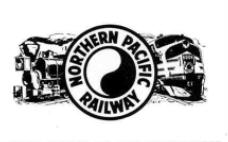
Northern Pacific Railroad
First of the Northern
Transcontinental Railroads
NORTH COAST LIMITED

The history of the Northern Pacific is a story colorful in adventure, rich in romance, and inspriring in achievement. It is the story of the opening and development of a vast wilderness and great public domanin, stretching from Lake Superior to the Columbia River and Puget Sound.The story of the Northern Pacific might properly begin with the explorations of Captains Meriwether Lewis and William clark in their notable expedition to the Pacific, which started up the Missouri River on May 14, 1804. The route finally selected by the
locating engineers of the Northern Pacific closely followed the explorations of the Lewis and Clark Expedition, by way of the valleys of the Yellowstone and Columbia Rivers. This route not only was one of the most dicussed but one of the first advocated for the location of a railroad connecting the Middle West with the Pacific Coast. It was known to be a favored route, following the fertile river valleys and over the broad plains for most of the distance, and thence across the great barrier of the Rocky Mountains at low elevations.
The Northern Pacific was the first of the northern transcontinental. It's history is a fascinating story of the opening of the West, because, with the progress of construction from Duluth, Minneapolis, and Superior, Wisconsin, to Puyot Sound in Washington, and the lower Columbia River in Washington and Oregon, the vast natural resources of the great Slates of Minnesota, North Dakota, Montana, Idaho, Oregon, and Washington for the first time became an important part of our national economy. Only an early settler
can remember how slowly our frontier settlements progressed before the railroad linked them with every other city and town in the country. Importance of the new railroad from an economic standpoint was, of course, obvious; but a second important factor was pointed out by General William T. Sherman, when he said: "The Northern Pacific must be built, both as an economic and military necessity. The West can never be settled, nor protected, without the railroad."
Early Plans and Surveys
Long before the Northern Pacific was chartered there were many who had worked hard in an effort to initiate this important railroad venture. One of the first was Dr. Samuel Bancroft Barlow of Massachusetts, who advocated a northern transcontinental line as early as 1834. Another was Asa Whitney, who conducted explorations for about fifteen hundred miles up the Missouri River in 1845, and earnestly importuned Congress to charter and authorize the construction of a railroad along the northern route. Much credit also is due Edwin F. Johnson, an eminent engineer who made intensive studies in the early 1850's with respect to a northern transcontinental line, which were published in book form and widely circulated.
The subject of a railroad to the Pacific commanded the intermittent attention of the U.S. Congress, beginning about 1840, for nearly a quarter century. Competing routes were debated and considered and, in 1853, an appropriation was made to cover surveys for five different routes. The northernmost route, the route of the Northern Pacific, was placed in charge of Isaac I. Stevens, an experienced Army officer who then was serving as Governor of Washington Territory. An important member of his party was Lieutenant John Mullan, who later was to build the first wagon road across the Rocky Mountains and whose memory is perpetuated by the Mullan Tunnel of the Northern Pacific. Still another member of the party who was to become widely known was Captain George B. McClellan, later Commander-in-Chief of the Army of the Potomac, during the Civil War. Stevens' report, printed in two huge volumes, showed the northern route to be a very favorable one, describing the country which would be served as rich in natural resources and potentially of great economic importance.
As a result of these several alternate surveys, sectional strife developed over the selection of a route, and it was not until 1862 that Congress passed a bill in aid of railroad construction along the middle route. This, however, did not discourage the advocates of the northern route. Josiah Perham of Massachusetts, who was to become first President of the Northern Pacific, continued intensive efforts, seeking a charter first from the Massachusetts legislature and later from tho Maine legislature, using this latter charter in an effort to persuade Congress to support his project. Finally, Congress passed an act creating the Northern Pacific Railroad Company, providing for a land grant, and naming as incorporators Mr. Perham and his friends, civic leaders, railroad men, and politicians. The act was signed by President Abraham Lincoln on July 2, 1864,—and thus began the Northern Pacific.
These pioneer incorporators, with all their enthusiasm and energy, were faced with almost insurmountable obstacles and difficulties in their efforts to carry forward this ambitious project, calling for the construction of a railroad across nearly two thousand miles of wilderness, from Lake Superior to the North Pacific Coast. Even with the aid of the land grant, construction funds could not be raised for some years.
Jay Cooke, the famed banker, traveled to Duluth in 1868 and saw potential in the state. He bought an interest in the Lake Superior-Mississippi Railroad, which traveled from Duluth to St. Paul. The following year Cooke became the banker for the Northern Pacific Railroad and subsequently part of the quest to lay track to the west.
In 1870, Jay Cooke and Co. gave a promise of $5 million, the Northern Pacific began laying down track. The ground breaking took place at Thomson's Junction near Duluth. First stirrings of activity on the west end of the projected transcontinental began at about the same time at Kalama, WA.

Home 
Continue